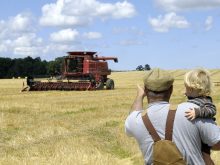When the federal government decides to put a highway through a town or new power lines across a province, many impact studies and town meetings are held to study how we will all be affected before a decision is made.
As the process progresses, individual landowners are compensated by the federal government at fair market prices and new roads and services are provided.
The federal government recently expropriated large tracts of farmland and lake front properties in the Humboldt area of Saskatchewan.
This was not for a highway or new services and not with any notice or intent of public meetings. The federal Department of Environment made a decision to force the closure of the culvert under grid 777. This in turn has caused large areas of farm and recreational property to be flooded.
Read Also

Crop profitability looks grim in new outlook
With grain prices depressed, returns per acre are looking dismal on all the major crops with some significantly worse than others.
As a result of this expropriation of land, the Saskatchewan Watershed Authority has been sent in to clean up a mess that they have been fighting to stop.
The authority has opposed the federal decision to close the culvert as it obstructs the natural flow of water in the area.
As a matter of fact, the cost of berms raising land … has cost the provincial department millions of dollars and just the maintenance and upgrade of these berms is projected at nearly $20 million.
Why is it that a provincial department is paying for a federal decision that they oppose? … The concerns of the local landowners stop with the Saskatchewan Watershed Authority, not the federal environment department, which should be atoning for its decisions.
Maybe if the Federal Department of Environment had held town meetings and talked to the Town of Humboldt about the future land expropriations they would be making by flooding land in the area, a true cost of such a decision could be made before it was enacted, instead of throwing money at it in hindsight.
I guess it really is easier to ask for forgiveness instead of permission and the only way the federal government will be forgiven is if it steps up with some real and fair compensation for the parties who are suffering.
Len and Marlene Therres,Morinville, Alta.
The summer of 1961 was hot, dry and dusty.
The driest parts of Saskatchewan got less than half of normal annual precipitation. Livestock producers were selling off animals while others held out for government freight assistance to bring in feed.
Crops in many areas were a write-off but for some producers in 25 rural municipalities there was hope of a crop insurance payment.
A pilot project launched in those RMs led to the creation of what is now known as Saskatchewan Crop Insurance Corp.
That pilot saw 194 farmers insure 31,700 acres of wheat, barley and oats, the only eligible crops.
Fifty years later, nearly 24,000 farmers insure about 25 million acres in a typical year. Coverage is available on 40 commercial crops, 25 pedigreed crops and 24 organic crops, plus forage and pasture.
Current general manager Cam Swan said the fact that the program was born from drought is characteristic of the province.
“By far and away the most significant losses we’ve had is when there is province-wide drought,” he said.
A cabinet order-in-council established the Saskatchewan Crop Insurance Board in September 1960 after several dry years.
The board asked for petitions to conduct a study and by the December deadline, it had submissions from 118 municipalities and more than 16,000 farmers.
But with little time to get applications and establish premiums and coverage rates, only 438 applications actually came in by Feb. 28, 1961. The board decided to operate a pilot in the east and northeast parts of the grain belt, and accepted 199 applications.
One of those belonged to Dan Krepakevich, who farms between Yorkton and Canora.
He has crop insurance contract number 11. He and three other original contract-holders have been in the program continuously for the last 50 years. Nineteen others have had insurance for 49 years.
“I stayed in it for the simple reason that people need insurance,” Krepakevich said.
“It may have been somewhat expensive but if it wasn’t for crop insurance in 1979, I wouldn’t be farming.”
First hail and then frost decimated
Krepakevich’s crop that year. From 1,200 acres, he harvested only four truckloads of grain.
Premiums that first year were expensive at 25 cents per acre. Coverage prices were $1 a bushel for wheat, 65 cents for barley and 45 cents for oats.
Coverage was area-based. Individual coverage wouldn’t arrive for 20 more years.
Krepakevich said he believes the biggest change is how premiums are charged and the fact that the program expanded from yield coverage to include quality.
“It’s not perfect,” he said, but he still thinks more people should participate. “You wouldn’t think of not insuring your house.”
Swan cites several milestones over the last 50 years.
In 1973, 32 crop insurance offices were established around the province to replace commissioned sales agents.
Also that year SCIC was established as a crown corporation.
In 1987, the head office relocated to Melville, where it now is home to Agristability and the Wildlife Damage Compensation program as well as crop insurance.
There are now more than 600 employees compared with four in the first year.
Adjusters have gone from using measuring wheels to GPS for their calculations.
They also use laptops out in the field and enter data immediately.
The corporation has also seen big changes in payouts and liability.
The largest payout was in the drought year of 2002, when $1.09 billion was paid on 100,000 claims. Early frost and wet harvest conditions also affected claim numbers.
“It was almost four, five times the amount of premium that we took in that year,” said Swan.
The next worst year was the drought of 1988, when $465 million or 3.8 times the premium was paid out.
Liability peaked at about $3.5 billion in 2008. Prices are up so much this year that Swan said liability could top $4 billion in 2011.
This year, most expect conditions to be wet. Krepakevich said he is planning on seeding canola and wheat if he can get on his land.
“In all my years I’ve never seen it this way,” he said.














